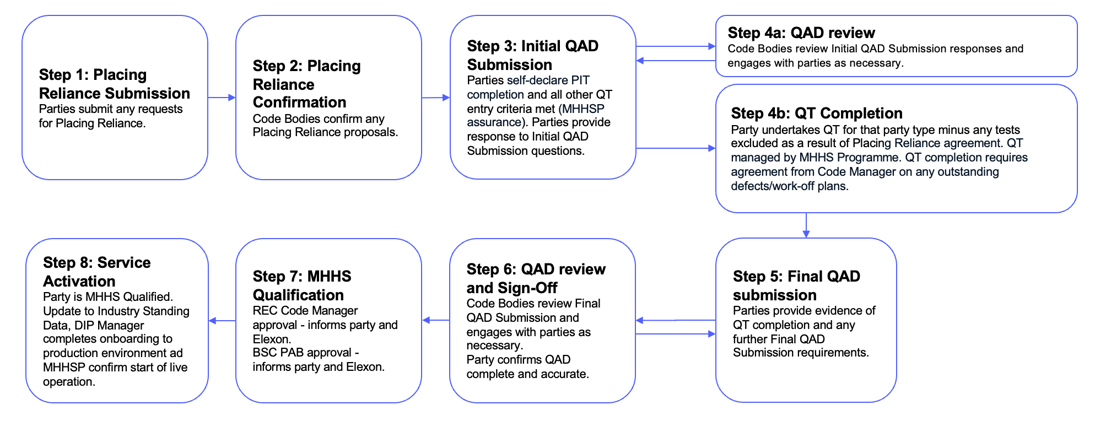Non-SIT LDSO Qualification
On this page you can find more information on the Non-Systems Integration Testing (SIT) Licensed Distribution System Operators (LDSO) route through Qualification.
Use the links below to find more information on key Non-SIT LDSO Qualification Deliverables and Artefacts:
- Non-SIT LDSO Test Execution
- Non-SIT LDSO Qualification Test Data
- Non-SIT LDSO Qualification Testing Test Scenarios and Test Cases
- Qualification Approach & Plan
- You can view the Qualification Approach & Plan and the accompanying Annexes, including Annex 1: Non-SIT LDSO MHHS Qualification Testing Approach
- Qualification Assessment Document
- All Programme participants will need to complete this document as part of their Qualification
If you have any questions, or you can't find what you're looking for, please email [email protected]


Non-SIT LDSO Qualification Testing Approach & Plan Template
The purpose of this document is to provide the Programme with an overview of Non-SIT LDSO Qualification Testing scope including Test Scenarios and Test Cases, test data and detailed schedule, and we requested participants to complete it with the following in mind:
- Placing Reliance approach
- Requirements to Test Traceability Matrix (RTTM)
- Opt Out of Data Integration Platform (DIP) Flows
Click on the link below to view the template:
Non-SIT LDSO Qualification Testing Approach & Plan Template
If you have any questions, please email [email protected]
Qualification Requirements to Test Traceability Matrix (RTTM)
Code Bodies have provided RTTM templates for each non-SIT Party type to support the assessment of testing activity.
They clarify minimum requirements for test execution in Pre-Integration Testing (PIT) and will set out what is expected for Qualification Testing as well as any evidence that must be provided e.g. to support the Qualification Assessment Document (QAD) submission.
Parties are required to complete the template to show that all tests have been executed and provide evidence of this.
To view the RTTM templates, please visit the Qualification Requirements to Test Traceability Matrix (RTTM) page of this website.


Placing Reliance, Qualification Testing (QT) and Pre-Integration Testing (PIT)
Non-SIT Licensed Distribution System Operators (LDSO)s that wish to Place Reliance on testing undertaken by others must submit a Non-SIT Placing Reliance Form to the MHHS Programme. Code Bodies review these Placing Reliance proposals and confirm to the MHHS Programme and Non-SIT LDSOs so that the scope of Qualification Testing (QT) is clear.
Each participant is required to complete Pre-Integration Testing (PIT) (assured by the MHHS Programme against defined PIT Exit Criteria) and undertake its other MHHS Qualification preparation activities, such as Data Integration Platform (DIP) onboarding. The party must then submit its Initial Qualification Assessment Document (QAD) as per timelines set out in Qualification Approach & Plan (QA&P) Appendix C.
More information on the Qualification Approach & Plan including the documents are available on the Qualification Approach & Plan page of this website. Code Bodies will review the initial QAD submission, seeking clarifications where required.
The MHHS Programme Qualification Test Manager manages QT on behalf of the Code Bodies. A more detailed explanation of the QT process is set out in the QA&P Annex 1: Non-SIT LDSO MHHS Qualification Testing Approach and Plan, also available on the Qualification Approach & Plan page of this website.
Non-SIT LDSOs should continue to develop the content of their final QAD submissions in parallel with QT.
Where a test cannot be completed in QT, we expect Non-SIT LDSOs to develop work-off plans, which are reviewed with the MHHS Programme Qualification Test Manager and agreed with Code Bodies.
Completion of Qualification Testing
Once a Non-SIT LDSO has completed QT (assured by the MHHS Programme against defined QT Exit Criteria), it is required to provide a final QAD submission. Code Bodies will review this document and work with the party to finalise it. Once the content has been agreed as complete for the purposes of MHHS Qualification, it must be signed by a Company Director.
Code Bodies will then approve MHHS Qualification for the Non-SIT LDSO in accordance with the QA&P Section 11.3 MHHS Qualification Approval. Once MHHS Qualified, the party must complete Service Activation before it can operate in the new MHHS arrangements.
The high-level preparation schedule for QT, is detailed below. More specific dates will be included in the Participant Checklist which you can find on the Planning page of this website. There are also timelines for submitting the QAD to Code Bodies that an LDSO needs to adhere to. These timelines are included in QA&P Appendix C.

Qualification Testing Preparation Schedule

